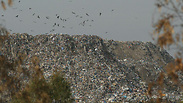
At least three such landfill sites have been established along the Gaza border in recent years, and the massive piles of rubbish can be clearly seen from Israel. The garbage creates foul smells, and has deemed 90 percent of the Strip's groundwater undrinkable.
The waste is primarily located in the area of Gaza bordering the Eshkol Regional Council, leaving the locals to cope with the putrid and toxic stench as it is carried by the wind across the border.
The landfills are derelict as dry and wet waste gets mixed up and subsequently burned, increasing the environmental impact. Insects and rodents that breed in the landfills then also make their way across the border, infesting the Israeli communities. In addition, disease-ridden cats and dogs that feed off the landfill constantly breach the fence, engendering the local residents.
"It's a daily war, and even though it may sound as something insignificant, swarms of mosquitoes invading from Gaza could result in a disaster for Israel," said a source in the Water Authority.
Furthermore, due to the dire economic situation in Gaza, the wastewater plant cannot undergo the needed treatments, prompting Palestinians living in the northern neighborhoods of the Strip—Beit Hanoun and Beit Lahia—to drain sewage into Nahal Hanun, which crosses Israel and empties into the sea, polluting the groundwater in the process.
The new facility is set to be located on the remains of the former Gush Katif settlement bloc. The estimated cost of tens of thousands of shekels is being met by the United Nations, which is helping Israel to coordinate the endeavor in the Gaza Strip. The recycling facility is expected to create precious jobs for Palestinians, and supply compost for the deteriorating agricultural sector in the Strip.
The accumulated waste almost caused an outbreak of violence two weeks ago, when a mountain of it collapsed and slid into the Gaza border perimeter area. IDF forces were ready to cross the border with heavy machinery to push the waste pile back into place, but the Coordinator of Government Activities in the Territories (COGAT) intervened in order to prevent a clash with Hamas, and brought in UN officials in the Strip.
Finally, after a series of discussions, the IDF allowed Palestinian bulldozers into the perimeter area in order to push the waste back into place, while Hamas openly observed.

















